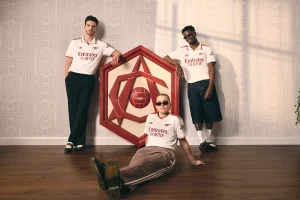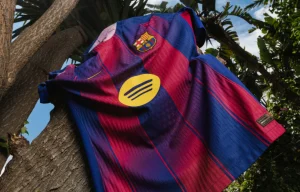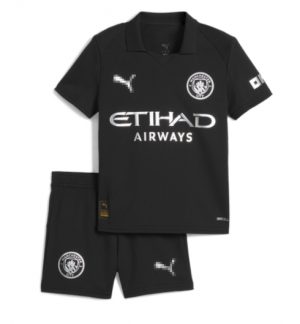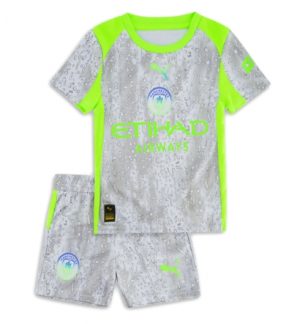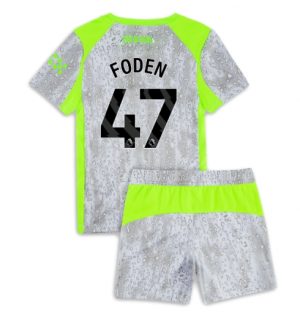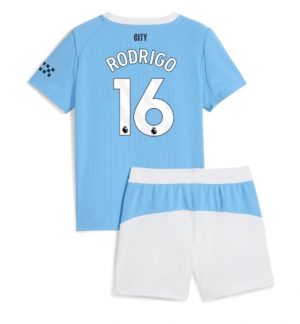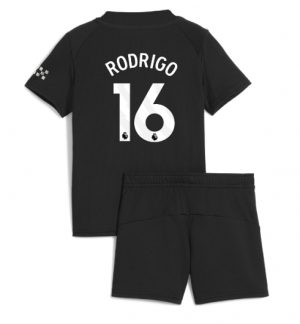1.Introduction
The AC Milan Kids Jersey are not just sportswear, they are an integral part of the club's culture and tradition. The colour combination of red and black has been a recognisable symbol for over a hundred years and Milan's jerseys are an important part of the club's identity both on and off the pitch. Each new jersey carries a piece of history and combines past and present.
The design of club jerseys is not just an aesthetic choice, technological developments have also played a key role in improving player performance. Football shirts have evolved considerably over the decades - from simple, traditional cotton shirts to high-tech materials to enhance performance.
In this blog, we look at the evolution of AC Milan's kit design and technology. We analyse how these changes reflect the evolution of the club and how the kits have changed over time, both aesthetically and functionally. The influence of the community and marketing has also been an important factor in the design of the jerseys - they are not just a tool to play in, but also part of the Milan brand that resonates in the hearts of fans and players around the world.
2 Origin and traditions of the jersey
AC Milan jerseys are an integral part of the club's heritage and culture. Founded in 1899, the club has been active in the red and black colours from the very beginning, which still enjoy cult status and are recognised all over the world. Initially, the club did not have a very wide choice of kit - plain, dark-coloured shirts were common, but the club's decision to wear red and black was more than just an aesthetic choice; it was a symbol.
Colours and symbolism
The colours red and black symbolise passion and strength at the same time and this combination has been the club's trademark since the very beginning. Milan's founders were partly inspired by English football clubs when choosing these colours, but also wanted to create something unique that would stand out from the rest. The colours were also a tribute to the Italian championship and vitality.
The club's first jersey was simple, but served as a solid foundation for the current design. In the early decades, jerseys were made from cotton and printing them was a laborious and expensive manual process. Back then, the club's jerseys were still quite simple and functional, but were not yet considered a fashion item. Nevertheless, the club jerseys were instantly recognisable thanks to their combination of red and black and their individuality.
The first steps in development
The first major changes to the jersey took place in the early 20th century. As technology developed and the sport of football became increasingly popular, the focus shifted more and more to jerseys. As early as the 1920s, club jerseys were lighter and more customised to the players. But even if the design of the jerseys was simple, they already reflected the traditions and identity of Milan at the time.
Logo and coat of arms
The crest, which is still a characteristic element of AC Milan's jerseys, was created in 1901 when the club adopted a black and red striped crest. This crest, which is still familiar to fans around the world today, was associated with the club's will to win and its ambitious attitude. The crest became an important part of the Milan shirt and can still be seen today, although its appearance has changed slightly over the decades.
Traditions and fan culture
Milan's jerseys have always been much more than just sportswear. They are a symbol of the club's traditions and community. For fans, the jersey is an important part of identity and pride. Wearing the Milan jersey has always been a sign of loyalty and love for the club. This tradition has been passed down from generation to generation and the jerseys have taken on a special meaning, especially during the club's golden years, such as the 1980s and 1990s, when Milan won several championships.
3. development of technology and materials
The development of the shirts was not limited to the visual design, the biggest changes were in the materials and technologies. Originally simple cotton shirts have undergone a long development. Playing and training wear for footballers has developed enormously since the early 20th century. This development has been particularly important for clubs such as AC Milan, who play among the world's best.
Early materials and traditions
AC Milan's jerseys were originally made from simple, heavy cotton. Cotton was the most commonly used material at the time, but it was not particularly breathable and could not withstand heavy use. In this case, players often found that the jerseys became heavier and more uncomfortable as the game progressed. In addition, cotton was not ideal in wet conditions as it absorbed moisture easily, making playing more difficult and tiring.
The first steps of the technology
Towards the end of the 20th century, the football clothing industry began to switch to more modern materials and in the 1970s, the first synthetic materials were used in jerseys. This was a big leap as these newer fabrics were lighter, more durable and much more breathable than traditional cotton. Synthetic materials such as polyester and nylon became very popular in football uniforms as they could wick moisture away from the body, improving the comfort of players on the pitch.
Breathability and moisture management
In the 1990s and early 2000s, the technological development of the jersey reached a new stage when high-tech sportswear brands such as Adidas and Nike began to develop materials specifically tailored to the needs of athletes. AC Milan's jerseys are equipped with advanced moisture management technologies such as Climacool and Dri-FIT, which keep players dry and comfortable during the game. These materials wicked sweat away from the body and prevented the effects of perspiration.
Thanks to these technologies, the jerseys felt much lighter and more comfortable, even after a long game. Breathable materials helped regulate body temperature, which improved player performance and reduced fatigue.
Lightness and durability
In the last decade, jersey design has increasingly focussed on the lightness and durability of jerseys. AC Milan jerseys are now made from specially woven fabrics that are extremely lightweight yet highly durable. These materials allow the players to move freely and agilely without the jersey restricting their freedom of movement.
A significant innovative step was the use of "Lasercut" technology for jerseys, in which materials are precisely cut with a laser. This enables an even more precise and lighter structure, which reduces the weight of the clothing and improves ventilation. This development is particularly important in top-level football, where seconds can decide the outcome of a game.
Environmental friendliness and sustainable development
The latest trend is also sustainable development and the use of environmentally friendly materials. AC Milan, like many other top clubs, has started to favour recycled and environmentally friendly materials for its jerseys. Nike, for example, has launched the "Nike VaporKnit" technology, which is made from recycled plastic bottles. This promotes environmentally friendly production and at the same time brings lightweight, breathable and high-performance jerseys to the market.
The role of the jersey in the player's performance
All of these significant changes are not just design or marketing improvements, but also have a direct impact on players' performance on the pitch. Lightweight and breathable materials improve players' mobility, reduce fatigue and help them focus on the essentials of the game. The durability of the jerseys is also a crucial factor, as it ensures that players can wear them for long periods of time without losing their shape or functionality.
4.design changes: From classic to modern
AC Milan's kits have undergone many changes over the decades and their design reflects the general development of the club and football. From the very beginning, the club's kits were recognisable by their red and black colour scheme, but at the same time their design and details have evolved and been updated over time. The changes to Milan's jersey design are not just visual, but are also linked to the club's strategic decisions and its position at the top of the world game.
The simplicity of the beginning: the first jerseys
AC Milan's original kits were very simple compared to today's complex and carefully designed outfits. The club initially used the traditional red and black stripes, which were already part of the club's identity. In the early years of the 20th century, shirts were often handmade and their design did not emphasise fashion or marketing. The shirt was practical and hard-wearing, but not just a fashion item.
Changes in the 1950s and 1960s: Accentuated stripes and logos
In the 1950s and 1960s, the jersey design attracted increasing attention. The stripes were clearer and wider, making them visually more striking and easier to recognise on the pitch. At this time, the club crest and logo on the jersey also became more important and appeared more frequently on the chest, making them stand out clearly from the stripes. Although the design was still quite traditional, these changes laid the foundations for the future look of Milan jerseys.
The golden era of the 1980s and 1990s: iconic jerseys
AC Milan jerseys reached their most iconic form in the 1980s and 1990s, when the club was at the top of Europe. During these years, the jerseys were golden classics in many respects, highly recognised by players and fans alike. One of the most famous design features at the time was the stunning simplicity of the jerseys produced by Adidas, which combined red and black stripes with a black logo and a black match number. High-quality materials and details were used for the jerseys, conveying Milan's championship and goals at the highest level.
Modern changes of the early 2000s: Graphic elements and sponsor logos
In the course of the 2000s, AC Milan's jerseys increasingly featured graphic and dynamic elements. The stripes were given multi-coloured accents and the jerseys increasingly featured the logos of the sponsors. At this time, more and more attention was paid to aerodynamics and player performance when designing the jerseys. For example, the seams of shirt and trouser fabrics were moved out of certain areas to allow greater freedom of movement. This period was also a time of marketing at the highest level, where the design of the jersey was as much a part of the club's branding as the game itself.
2010s: Innovation and experimentation
In the 2010s, AC Milan's jersey designs became more experimental and bold. Collaborations with top brands such as Nike created space for innovation and the jerseys increasingly used more technical elements, such as lighter materials and breathable mesh materials. At the same time, the jerseys were given new visual elements: new stripes, the use of geometric patterns and larger sponsor logos. Milan's jerseys increasingly reflected the club's modern status and international visibility.
Modern minimalist and high-tech design
Today, Milan's jerseys are a combination of cutting-edge technology and minimalist design. One of the biggest changes has been the emphasis on a simple and elegant look, keeping the traditional red and black colour and stripes, but keeping everything else as simple as possible. Newer designs focus on improving the materials and technology used in the jerseys rather than just visual changes.
The design of the jerseys is now lighter and more efficient in terms of player performance. The entire design is optimised for freedom of movement, breathability and durability. At the same time, the jerseys increasingly represent the club's brand: they symbolise a winning culture, dedication and the pinnacle of football.
The future of design: collaboration and sustainability
Jerseys will certainly continue to evolve in the future, especially with regard to sustainability aspects. AC Milan emphasises the use of environmentally friendly materials and in the future, jerseys could be even more recycled and sustainable. The design of the match jersey will not only evolve visually, but also in terms of its functionality and environmental compatibility.
5 The role of fans and marketing
AC Milan jerseys are not just sportswear, they are an integral part of the club's culture and identity. They tell a story that is not only about the players' performances on the pitch, but also about the fans and the club's global brand. It is often the fans who give the jersey its true meaning - they not only wear it, but symbolise the connection between the club and its supporters. At the same time, marketing has turned the jersey into a product that goes beyond sport and reaches a wider audience.
The role of the fans in the jersey
The AC Milan jersey has always been much more than just a piece of clothing on the pitch. It is an identity, a symbol and a source of pride. By wearing the jersey, fans feel a connection to the club and it is an outward sign that they are part of something bigger - a culture, tradition and history of victory. The sale of jerseys is one of the most important ways for fans to show their support for the club.
The fans have played their part in creating and maintaining the importance of the jersey. For example, Milan's worldwide fan communities not only buy the jerseys, but are even involved in designing their look and providing feedback, which in turn influences which jerseys we will see in the future.
Marketing and commercialisation
Marketing has played a key role in the development of AC Milan's jerseys. Although jerseys have always been part of the club's brand, their commercialisation has taken on a new dynamic in recent decades. Major sportswear brands such as Nike and Adidas have played a key role in the design and sale of jerseys. The design of the match jersey is now as much a fashion trend as an item of clothing for sporting use.
With this commercialisation, the jersey has become an important branded product that is part of a larger business. Marketing is not limited to fans buying jerseys around matches. It also extends to various campaigns where the jersey is combined with other club branding, such as special community projects, joint events or players' personal brands.
Global markets and cultural exchange
AC Milan jerseys are not only known in Milan or Italy. The club is one of the global football icons and its jerseys are popular all over the world. Thanks to the global nature of football and the club's strong marketing, the AC Milan jersey is recognisable all over the world. The jersey is therefore a vehicle for cultural exchange: the logo and colours of Milan unite different nationalities and language groups who share a common love of football and the club's history.
Co-operations and special collections
In recent years in particular, AC Milan has collaborated with various brands and fashion houses to create special collections with limited availability. The jersey is not just field wear, but also part of high-quality fashion. Special editions and "vintage" models, for example, have turned the jersey into a coveted collector's item that attracts attention even among non-football fans.
Such collaborations have increased the value of the AC Milan brand and reached new target groups for whom the jersey is a fashion-conscious and iconic garment and not just a tool for sporting performance. These special collections have also created stories around their values and symbolism, bringing together the club's traditions and today's fashion world into a unified whole.
The connection between fans and players in the jersey
The jersey is not only important for the fan, but also represents an important part of the connection between the players and their supporters. The players who wear the AC Milan jersey are not just individual athletes on the pitch; they represent the club, its history and its fans. Fans recognise players by their shirts and the players in turn feel that they carry the community and its hopes into the game.
The relationship between fans and players is crucial to the culture and success of a club. The jersey is therefore a symbol that unites both the pitch side and the spectator side - together, the jersey creates an identity that transcends borders and generations.
The role of gaming events and social media
Social media has ushered jersey marketing into a new era. Now AC Milan can engage directly with its fans around the world and share new kit launches, special events and player-specific projects. Social media marketing campaigns are important because they reach a wide and diverse audience. The launch of new kits is accompanied by campaigns and pictures of the players in the new kits, which leads to discussions and increases the demand for the kits.
6 Current trends and future prospects
6.1 Sustainable development and environmental friendliness
Nowadays, AC Milan jerseys are increasingly made from recycled and environmentally friendly materials. Nike, for example, uses recycled plastic bottles in its materials. This trend is set to increase in the future as the club invests in more sustainable production methods.
6.2 The role of technology
Jerseys are no longer just clothing, but can also contain technology that measures a player's performance. This technology will continue to evolve and in the future, jerseys will be able to capture players' physiological data more accurately.
6.3 Fashion trends
Jerseys are not only increasingly found in sport, but also in the fashion world. There are often special, fashionable collections for AC Milan jerseys that appeal to a wider audience, including non-football fans.
6.4 Fan engagement
Fans can increasingly influence the design of their jerseys and clubs like AC Milan ask their fans for ideas and feedback. This strengthens the bond between the club and its supporters.
6.5 Social news
In future, jerseys could carry social and political messages, such as symbols for equality or environmental protection. Clubs such as AC Milan have already started to emphasise social issues in their brands.
7.Summary
AC Milan jerseys have undergone significant changes over the decades and their development has been closely linked to trends in the football and fashion industry. The development of jersey technology and materials has been crucial, as more sustainable materials such as recycled plastics and advanced technologies make them even more functional and environmentally friendly. At the same time, jerseys have evolved from mere field gear to a part of global fashion and culture.
In the future, we can expect the role of jerseys to become even more diverse. Innovative materials, technology integration and the involvement of fans in the design process will be the key factors that determine the further development of AC Milan's jerseys. In addition, jerseys can increasingly convey social messages and serve as channels for important discussions.
If you want to find out more about the AC Milan jerseys and buy your own jersey, you can cheapjerseys.com where you will find a large selection of jerseys and fan merchandise.


